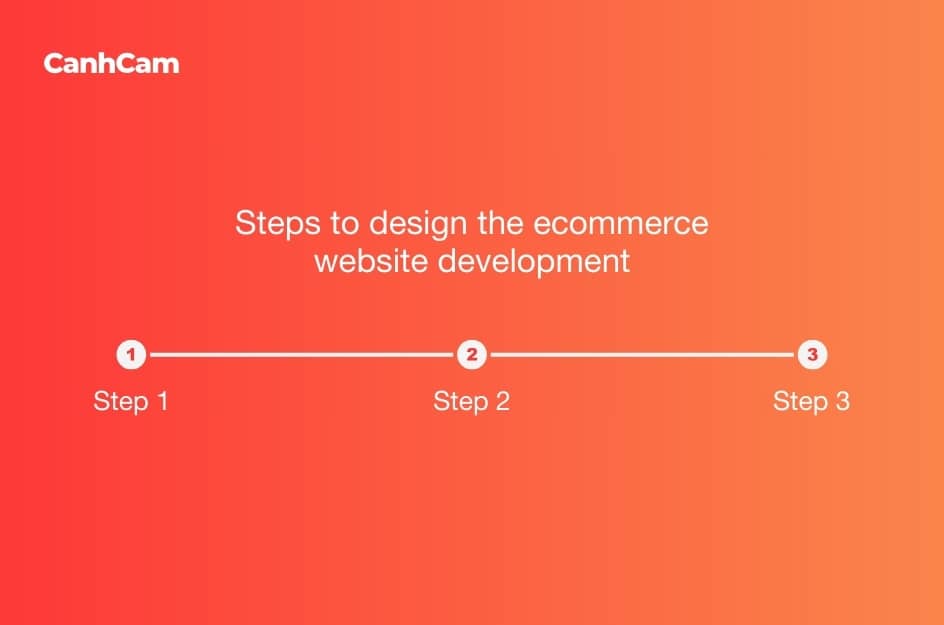In the ever-evolving digital landscape, Ecommerce Website Design and Development play a vital role in shaping businesses' online presence. This introduction delves into the dynamic world of crafting and nurturing online stores, emphasizing the significance of strategic design and development.
With millions of active ecommerce sites globally, the key to standing out lies in superior website development. This process involves determining functionality, payment processes, user response, and aesthetic appearance. Valued at $11 billion in 2022, the web development services industry offers opportunities or businesses to address ecommerce challenges and launch user-friendly websites.
As online sales claim a significant share of the global retail market, having a well-developed ecommerce website is essential. Beyond visual appeal, it translates into actual sales and profits by streamlining the order process and building brand equity. E-commerce website design requires meticulous planning, building, and optimization to create a user-friendly portal.
This comprehensive guide provides insights to make informed decisions about e-commerce website development, ensuring your online presence aligns with modern standards and user expectations.
What is Ecommerce Website Design and Development?
Ecommerce website design and development are the essential processes behind creating and optimizing online platforms for buying and selling goods or services. They encompass a blend of visual design, user experience optimization, and technical implementation to craft seamless and engaging online shopping experiences. From intuitive navigation to secure payment gateways, every detail is meticulously designed to enhance user satisfaction and drive conversions.
Visit Our Services: web design services in Melbourne

Why is design and development important in an e-commerce website?
In the fast-paced digital landscape, e-commerce website design and development are not just elements; they are the heartbeat of online success. As the global e-commerce market gears up to soar beyond $6.38 trillion by 2024 (source: Statista), a robust online presence becomes the key differentiator for businesses. These processes involve meticulously crafting platforms, ensuring seamless transactions, and elevating user experiences. From intuitive navigation to secure payment gateways, every detail works harmoniously to amplify user satisfaction and drive conversions.

An effective e-commerce website isn't just a choice; it's a necessity. Statistics reveal that a staggering 87% of shoppers initiate their product searches online (source: Salesforce), underscoring the significance of a formidable online presence. E-commerce website design and development are not merely tools for sales; they emerge as potent forces for branding and marketing. They empower businesses to not only attract and engage customers but also retain them in the dynamic realms of the digital universe.
The verdict is clear: investing in top-notch e-commerce website design and development isn't just a wise move; it's an indispensable strategy for businesses navigating the digital age.
Steps to Design the Ecommerce Website Development
To Design and Development your Ecommerce website, follow this steps:
Establishing Your Brand
The essence of ecommerce website design and development transcends mere transactions; it becomes a symphony of brand expression and user experience.
Conduct Brand Identity Workshops
Navigating the intricacies of ecommerce begins with defining your brand's identity. Conducting brand identity workshops is akin to crafting the DNA of your online persona. Gather your team and delve into the core values, mission, and vision that define your business. Unearth the unique selling propositions that set you apart in the competitive digital sphere.
Create a Unique Brand Voice and Tone
Your brand's voice is its heartbeat. Cultivate a distinct voice and tone that resonate with your target audience. Whether it's conversational, formal, or playful, align your brand communication with the emotions you want to evoke. Craft compelling product descriptions, engaging social media posts, and resonant taglines that echo your brand's personality.
Develop a Brand Style Guide
Consistency is the linchpin of a memorable brand. Enter the realm of ecommerce with a meticulously crafted brand style guide. From logo usage and color palettes to typography and imagery, articulate the visual elements that embody your brand. A cohesive visual identity across your website and marketing materials fosters recognition and trust among your audience.
This trinity of brand establishment — workshops, voice cultivation, and style guide creation — sets the foundation for a compelling ecommerce presence. As you weave your brand narrative into the digital fabric, remember, it's not just about selling; it's about creating an immersive brand experience.

Choosing a Platform and Domain
Navigating the selection of the right platform and domain involves a strategic interplay of market insights, user preferences, and a keen understanding of your customer base.
Conduct Market Research and User Surveys
Begin your journey by diving deep into market research. Explore the platforms that resonate with your industry and audience. Beyond market trends, embark on a mission to understand your potential customers. Craft surveys that unravel their preferences, online habits, and expectations from an ecommerce platform. This groundwork lays the foundation for informed decisions.
Analyze Customer Behavior and Purchase Patterns
Leverage analytics tools to unravel the journey users undertake on ecommerce platforms. Analyze the data to discern patterns — from the products they linger on to the point of purchase. This insight becomes a compass, guiding you towards a platform that aligns seamlessly with your customers' habits.
Identify Pain Points and Preferences
Every customer interaction carries a trove of insights. Identify the pain points users encounter on existing platforms, seeking the gaps waiting to be filled. Simultaneously, uncover their preferences — the features that delight them. This dual exploration ensures your chosen platform not only addresses existing challenges but also becomes a canvas to showcase the elements customers adore.
Choosing a platform and domain isn't a mere technical decision; it's a strategic investment based on profound insights. As you navigate this terrain, envision not just a digital storefront but a responsive ecosystem tailored to the heartbeat of your audience.
Designing Your Site
In this phase, we navigate the canvas of your website, creating an immersive experience that transcends conventional boundaries. Let's delve deeper into the artistry of ecommerce website design and development.
Implement Storytelling Techniques
Elevate your ecommerce website from a transactional platform to a narrative-rich journey. Storytelling is a potent tool that humanizes your brand and resonates with your audience. Weave a compelling narrative around your products or services, engaging visitors emotionally. Whether through impactful visuals, persuasive copy, or user testimonials, let your brand story unfold with each click.
Incorporate Interactive Elements
Interactivity is the “secret sauce” that keeps users engaged. Integrate interactive elements seamlessly into your website design. From product galleries with zoom features to immersive 360-degree views, create an interactive playground for your visitors. Interactive quizzes, chatbots, or personalized product recommendations add layers to the user experience.
Create Seamless Multi-Channel Experiences
The modern consumer doesn't follow a linear path. Crafting a seamless multi-channel experience ensures that your audience can seamlessly transition from desktop to mobile, social media to your website. Implement responsive design, optimize for various devices, and synchronize your messaging across channels. Consistency in the user experience fosters trust and encourages cross-channel engagement.
Coding Your Website
Evaluate Emerging Technologies
Coding your website involves staying at the forefront of technological advancements. Evaluate emerging technologies that can elevate your ecommerce platform. Whether it's the integration of augmented reality (AR) for immersive product experiences or blockchain for secure transactions, choose technologies that align with your business goals and enhance user engagement.
Select Scalable Backend Solutions
The backbone of your ecommerce website resides in its backend architecture. Opt for scalable backend solutions that can accommodate the growth of your business. Whether it's cloud-based solutions or modular frameworks, scalability ensures your website can handle increased traffic, transactions, and evolving functionalities without compromising performance.
Integrate AI-Powered Personalization Engines
Coding your website involves incorporating AI-powered engines to tailor the user experience. Implement personalized product recommendations, dynamic pricing, and intelligent chatbots. The artful integration of artificial intelligence enhances user engagement, increases conversions, and creates a personalized journey for every visitor.
Optimizing Your Design
Implement Progressive Web App Features
Optimizing your design extends beyond aesthetics; it's about ensuring a seamless experience across devices. Implement progressive web app (PWA) features in your coding strategy. PWAs offer the responsiveness of a native app combined with the accessibility of a web browser, delivering a fast and engaging experience for mobile users.
Design Thumb-Friendly Interfaces
In a world dominated by mobile users, designing thumb-friendly interfaces is paramount. Consider the ergonomics of navigation and interaction. Optimize button placement, streamline checkout processes, and ensure that users can effortlessly navigate your website with a simple thumb gesture.
Leverage Mobile-Specific Features
Coding for optimization involves leveraging mobile-specific features. Whether it's integrating mobile payment options, utilizing geolocation for personalized experiences, or implementing touch gestures for intuitive navigation, maximize the capabilities of mobile devices to create a user-centric ecommerce platform.
Getting Ready to Launch
Secure Transactions with SSL Certificates
Trust is the currency that fuels ecommerce transactions. Elevate the security of your online store by implementing SSL certificates. These cryptographic protocols ensure secure data transmission between your website and users, safeguarding sensitive information such as payment details. Showcasing a secure environment not only protects your customers but also establishes your credibility as a trustworthy online entity.
Display Trust Badges and Customer Reviews
Building trust goes beyond technical measures; it extends into the visual and social realms. Embed trust badges prominently on your website to signal security certifications and affiliations. Additionally, leverage the power of customer reviews. Showcase positive feedback and testimonials to instill confidence in potential buyers. A transparent display of customer experiences acts as a virtual recommendation, guiding new visitors toward a sense of reliability.
Implement Fraud Detection Systems
Implementing robust fraud detection systems adds an extra layer of protection. Utilize AI-driven algorithms and real-time monitoring to identify and thwart fraudulent activities. By actively safeguarding your platform, you not only protect your business from financial loss but also foster a secure environment that encourages customers to transact with peace of mind.
As you prepare to launch your ecommerce venture, fortify its foundation with these security measures. SSL certificates, trust badges, and fraud detection systems collectively form the shield that guards your customers' trust, paving the way for a seamless and secure online shopping experience.
Maintaining Your Site
Utilize Advanced Product Information Management Systems
Enter the era of precision with advanced Product Information Management (PIM) systems. These sophisticated tools transcend traditional data management, offering a centralized hub for product information. Streamline your product catalogs, enrich content, and ensure accuracy across all touchpoints. Elevate the customer experience by delivering consistent and detailed product information, fostering trust and loyalty.
Enable Dynamic Content Syndication
Static content falls short of capturing the audience's attention. Embrace the power of dynamic content syndication, a symphony of agility and relevance. Distribute your compelling content across multiple channels, adapting it in real-time to suit diverse platforms. Whether it's product updates, promotions, or engaging stories, let your content resonate dynamically across the digital ecosystem.
Automate Inventory Management and Order Fulfillment
Implementing advanced automation tools for inventory management and order fulfillment ensures a graceful rhythm in your operations. From real-time inventory tracking to automated order processing, these systems optimize efficiency, reduce errors, and enhance the overall customer experience. Free your team from mundane tasks and let automation choreograph the intricate dance of inventory and fulfillment.
Crafting a Comprehensive Marketing Strategy
Navigating the bustling realm of ecommerce involves more than just a visually appealing website; it demands a comprehensive marketing strategy that propels your brand into the digital spotlight.
Develop Data-Driven Digital Marketing Campaigns
In the data-driven landscape of ecommerce, informed decisions are the keystones of success. Develop digital marketing campaigns that resonate with your audience's preferences, behaviors, and demographics. Leverage analytics tools to gain insights into user interactions, refine your targeting, and optimize your campaigns for maximum impact. From pay-per-click (PPC) ads to social media promotions, let data be your guiding light in the expansive digital marketing universe.
Utilize Influencer Marketing and User-Generated Content
Collaborate with influencers relevant to your industry, harnessing their reach and credibility to amplify your message. Additionally, empower your community by encouraging user-generated content. Transform your customers into brand ambassadors, fostering authenticity and trust. An amalgamation of influencer allure and genuine user experiences forms a powerful catalyst for ecommerce success.
Implement Email Marketing Automation
Staying connected with your audience is paramount. Implement email marketing automation to streamline communication and nurture customer relationships. Craft personalized and targeted email campaigns that align with customer preferences and behavior. From abandoned cart reminders to exclusive offers, automation ensures timely and relevant interactions, fostering customer engagement and loyalty.
Testing, Iterating, and Improving Continuously
E-commerce website design and development doesn't end with the launch; it evolves through continuous testing, refinement, and innovation.
Conduct A/B Testing for Website Elements and User Flows
Elevate your website's performance by engaging in A/B testing. This methodical approach involves presenting variations of specific elements or user flows to different segments of your audience. Analyze the data to discern which version resonates best with your users. Whether it's tweaking the call-to-action buttons, refining product page layouts, or optimizing checkout processes, A/B testing empowers you to make data-driven decisions for an enhanced user experience.
Gather Customer Feedback and Analyze User Behavior
Your customers hold the key to unlocking valuable insights. Actively seek feedback through surveys, reviews, and customer support interactions. Dive into the sea of analytics to understand user behavior on your website. Track the pages they visit, the products they explore, and the actions they take. This feedback loop provides a compass for refining your ecommerce strategy, ensuring it aligns seamlessly with the evolving needs and preferences of your audience.
Regularly Update and Innovate Website Features
Regular updates and innovations breathe life into your ecommerce platform. Stay abreast of industry trends, technological advancements, and user expectations. Integrate new features that enhance the user experience, boost engagement, and keep your brand at the forefront of innovation.

Launching and Scaling Strategically
The next phase of your ecommerce venture, where meticulous planning and astute scaling become the guiding principles.
Plan a Soft Launch to Test Website Performance
Before the grand stage, a soft launch sets the scene. Think of it as a dress rehearsal for your ecommerce performance. Release your website to a limited audience, allowing for real-time testing of its functionality, user experience, and overall performance. Solicit feedback, identify glitches, and refine your online stage for the main act.
Monitor Website Analytics and KPIs
Leverage analytics tools to scrutinize website data and key performance indicators (KPIs). Track user behavior, engagement metrics, and conversion rates. Unearth patterns and trends that illuminate the effectiveness of your ecommerce strategies. These insights serve as your compass, guiding decisions for the journey ahead.
Scale Website Infrastructure and Marketing Efforts Gradually
As the applause grows louder, it's time to scale your ecommerce infrastructure and marketing endeavors. Gradual scaling allows for a seamless transition as your audience expands. Enhance server capabilities, optimize website speed, and fortify security measures. Simultaneously, amplify marketing efforts, tapping into channels that resonate with your evolving audience.
Conclusion
As we conclude this exploration into the world of ecommerce website design and development, remember that each strategic step contributes to your online success. Embrace the insights shared here, stay agile in adopting trends, and trust in the expertise of professionals to make your ecommerce venture thrive.
Frequently Asked Questions (FAQs)
1. What is the role of an ecommerce website developer?
E-commerce developers use back-end programming and frontend design skills in order to make the online store have a simple navigation and secured transaction processes.
Installation of efficient and aesthetically appealing stores.
Put up filters for simple product search.
Bring the features that increase the value of your site to notice
2. How do I determine what features my ecommerce website needs?
Determine your ecommerce website's essential features based on your business model and goals:
- Align features with your customer lifecycle and objectives.
- Prioritize
- Responsive design.
- Strong SEO.
- Fast page loading.
- Integration with social media and marketplaces.
- Multiple payment options.
- CMS integration.
- Effective shopping cart and product filtering.
Tips for your e-commerce website
Craft Compelling Product Descriptions:
- Write clear, concise, and persuasive product descriptions.
- Highlight key features, benefits, and unique selling points.
- Use language that resonates with your target audience.
- Incorporate relevant keywords for SEO.
Optimize Product Images:
- Capture high-quality images with proper lighting and angles.
- Ensure consistency in image style across your product range.
- Implement zoom features for customers to examine products closely.
- Compress images without compromising quality for faster loading times.
Invest in Professional Photography:
- Consider hiring a professional photographer for product shots.
- Showcase products in real-world scenarios to help customers visualize usage.
- Maintain a consistent aesthetic to strengthen brand identity.
Implement a Detailed Product Information Section:
- Provide comprehensive details about each product.
- Include specifications, sizes, materials, and any relevant technical information.
- Mention care instructions or any additional product-related information.
- Offer size guides, charts, or compatibility details when applicable.
Utilize Customer Reviews and Testimonials:
- Display customer reviews and testimonials prominently.
- Encourage customers to share their experiences with purchased products.
- Respond to customer reviews, showing engagement and reliability.
Implement Clear Calls-to-Action (CTAs):
- Use visually appealing and strategically placed CTAs.
- Direct customers toward actions like "Add to Cart" or "Buy Now."
- Optimize the placement of CTAs based on user behavior analytics.
Regularly Update Product Information:
- Keep product information up-to-date, including prices and availability.
- Remove or mark products as "out of stock" to avoid customer frustration.
- Highlight new arrivals or featured products on a dedicated section.
Personalize User Experience:
- Implement personalization features based on customer preferences.
- Recommend related products or items frequently bought together.
- Leverage customer data to create a tailored shopping experience.

